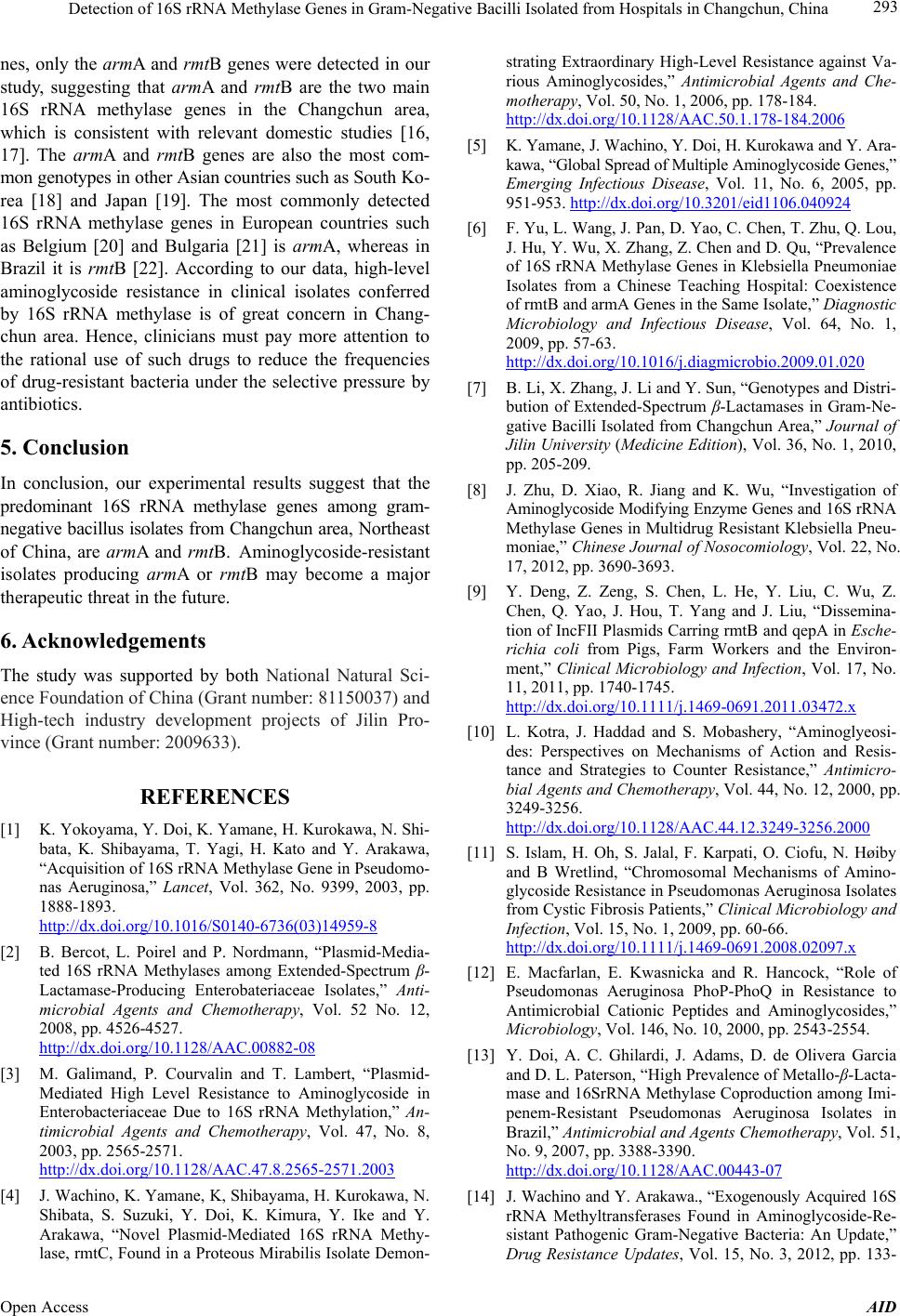
Detection of 16S rRNA Methylase Genes in Gram-Negative Bacilli Isolated from Hospitals in Changchun, China 293
nes, only the armA and rmtB genes were detected in our
study, suggesting that armA and rmtB are the two main
16S rRNA methylase genes in the Changchun area,
which is consistent with relevant domestic studies [16,
17]. The armA and rmtB genes are also the most com-
mon genotypes in other Asian countries such as South Ko-
rea [18] and Japan [19]. The most commonly detected
16S rRNA methylase genes in European countries such
as Belgium [20] and Bulgaria [21] is armA, whereas in
Brazil it is rmtB [22]. According to our data, high-level
aminoglycoside resistance in clinical isolates conferred
by 16S rRNA methylase is of great concern in Chang-
chun area. Hence, clinicians must pay more attention to
the rational use of such drugs to reduce the frequencies
of drug-resistant bacteria under the selective pressure by
antibiotics.
5. Conclusion
In conclusion, our experimental results suggest that the
predominant 16S rRNA methylase genes among gram-
negative bacillus isolates from Changchun area, Northeast
of China, are armA and rmtB. Aminoglycoside-resistant
isolates producing armA or rmtB may become a major
therapeutic threat in the future.
6. Acknowledgements
The study was supported by both National Natural Sci-
ence Foundation of China (Grant number: 81150037) and
High-tech industry development projects of Jilin Pro-
vince (Grant number: 2009633).
REFERENCES
[1] K. Yokoyama, Y. Doi, K. Yamane, H. Kurokawa, N. Shi-
bata, K. Shibayama, T. Yagi, H. Kato and Y. Arakawa,
“Acquisition of 16S rRNA Methylase Gene in Pseudomo-
nas Aeruginosa,” Lancet, Vol. 362, No. 9399, 2003, pp.
1888-1893.
http://dx.doi.org/10.1016/S0140-6736(03)14959-8
[2] B. Bercot, L. Poirel and P. Nordmann, “Plasmid-Media-
ted 16S rRNA Methylases among Extended-Spectrum β-
Lactamase-Producing Enterobateriaceae Isolates,” Anti-
microbial Agents and Chemotherapy, Vol. 52 No. 12,
2008, pp. 4526-4527.
http://dx.doi.org/10.1128/AAC.00882-08
[3] M. Galimand, P. Courvalin and T. Lambert, “Plasmid-
Mediated High Level Resistance to Aminoglycoside in
Enterobacteriaceae Due to 16S rRNA Methylation,” An-
timicrobial Agents and Chemotherapy, Vol. 47, No. 8,
2003, pp. 2565-2571.
http://dx.doi.org/10.1128/AAC.47.8.2565-2571.2003
[4] J. Wachino, K. Yamane, K, Shibayama, H. Kurokawa, N.
Shibata, S. Suzuki, Y. Doi, K. Kimura, Y. Ike and Y.
Arakawa, “Novel Plasmid-Mediated 16S rRNA Methy-
lase, rmtC, Found in a Proteous Mirabilis Isolate Demon-
strating Extraordinary High-Level Resistance against Va-
rious Aminoglycosides,” Antimicrobial Agents and Che-
motherapy, Vol. 50, No. 1, 2006, pp. 178-184.
http://dx.doi.org/10.1128/AAC.50.1.178-184.2006
[5] K. Yamane, J. Wachino, Y. Doi, H. Kurokawa and Y. Ara-
kawa, “Global Spread of Multiple Aminoglycoside Genes,”
Emerging Infectious Disease, Vol. 11, No. 6, 2005, pp.
951-953. http://dx.doi.org/10.3201/eid1106.040924
[6] F. Yu, L. Wang, J. Pan, D. Yao, C. Chen, T. Zhu, Q. Lou,
J. Hu, Y. Wu, X. Zhang, Z. Chen and D. Qu, “Prevalence
of 16S rRNA Methylase Genes in Klebsiella Pneumoniae
Isolates from a Chinese Teaching Hospital: Coexistence
of rmtB and armA Genes in the Same Isolate,” Diagnostic
Microbiology and Infectious Disease, Vol. 64, No. 1,
2009, pp. 57-63.
http://dx.doi.org/10.1016/j.diagmicrobio.2009.01.020
[7] B. Li, X. Zhang, J. Li and Y. Sun, “Genotypes and Distri-
bution of Extended-Spectrum β-Lactamases in Gram-Ne-
gative Bacilli Isolated from Changchun Area,” Journal of
Jilin University (Medicine Edition), Vol. 36, No. 1, 2010,
pp. 205-209.
[8] J. Zhu, D. Xiao, R. Jiang and K. Wu, “Investigation of
Aminoglycoside Modifying Enzyme Genes and 16S rRNA
Methylase Genes in Multidrug Resistant Klebsiella Pneu-
moniae,” Chinese Journal of Nosocomiology, Vol. 22, No.
17, 2012, pp. 3690-3693.
[9] Y. Deng, Z. Zeng, S. Chen, L. He, Y. Liu, C. Wu, Z.
Chen, Q. Yao, J. Hou, T. Yang and J. Liu, “Dissemina-
tion of IncFII Plasmids Carring rmtB and qepA in Esche-
richia coli from Pigs, Farm Workers and the Environ-
ment,” Clinical Microbiology and Infection, Vol. 17, No.
11, 2011, pp. 1740-1745.
http://dx.doi.org/10.1111/j.1469-0691.2011.03472.x
[10] L. Kotra, J. Haddad and S. Mobashery, “Aminoglyeosi-
des: Perspectives on Mechanisms of Action and Resis-
tance and Strategies to Counter Resistance,” Antimicro-
bial Agents and Chemotherapy, Vol. 44, No. 12, 2000, pp.
3249-3256.
http://dx.doi.org/10.1128/AAC.44.12.3249-3256.2000
[11] S. Islam, H. Oh, S. Jalal, F. Karpati, O. Ciofu, N. Høiby
and B Wretlind, “Chromosomal Mechanisms of Amino-
glycoside Resistance in Pseudomonas Aeruginosa Isolates
from Cystic Fibrosis Patients,” Clinical Microbiology and
Infection, Vol. 15, No. 1, 2009, pp. 60-66.
http://dx.doi.org/10.1111/j.1469-0691.2008.02097.x
[12] E. Macfarlan, E. Kwasnicka and R. Hancock, “Role of
Pseudomonas Aeruginosa PhoP-PhoQ in Resistance to
Antimicrobial Cationic Peptides and Aminoglycosides,”
Microbiology, Vol. 146, No. 10, 2000, pp. 2543-2554.
[13] Y. Doi, A. C. Ghilardi, J. Adams, D. de Olivera Garcia
and D. L. Paterson, “High Prevalence of Metallo-β-Lacta-
mase and 16SrRNA Methylase Coproduction among Imi-
penem-Resistant Pseudomonas Aeruginosa Isolates in
Brazil,” Antimicrobial and Agents Chemotherapy, Vol. 51,
No. 9, 2007, pp. 3388-3390.
http://dx.doi.org/10.1128/AAC.00443-07
[14] J. Wachino and Y. Arakawa., “Exogenously Acquired 16S
rRNA Methyltransferases Found in Aminoglycoside-Re-
sistant Pathogenic Gram-Negative Bacteria: An Update,”
Drug Resistance Updates, Vol. 15, No. 3, 2012, pp. 133-
Open Access AID